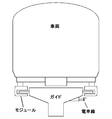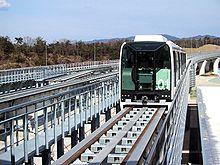High speed surface transport
High Speed Surface Transport (HSST) is a Japanese magnetic levitation train for urban passenger transport.
system
The drive from HSST is based on the principle of the linear motor . In contrast to the Transrapid , the stator of the linear motor is installed in the vehicle and not in the rails. Since no voltage can be induced in this way, the vehicles always need a power supply (275 V), which is produced via grinders to the rails. The electromagnets are positioned under the rails, so that the train attracts itself towards the rails and does not repel it as with the JR Maglev . The distance to the rail is controlled by a sensor.
The key technology HSST was transferred from Krauss-Maffei Transurban.
Test facilities and vehicles
HSST-01
HSST-01 was developed in 1974 and reached a speed of 307.8 km / h in 1978.
HSST-02
HSST-02 was built in 1981 and offered space for two people, the test vehicle reached a speed of 110 km / h. The vehicle is guided inside.
HSST-03
The test vehicle HSST-03 was completed for Expo '85. It is 13.8 m long, 3 m wide and weighs 12 tons and is now in Minami Park in Okazaki, Japan.
HSST-04
HSST-04 was completed in 1988 and was the first generation to be externally led. It was 19.4 m long, 3 m wide, weighed 20 tons and had a top speed of 40 km / h.
HSST-05
The test vehicle HSST-05 was the first two-part vehicle and was built in 1989. It was 36.3 m long, 3 m wide, weighed 40 tons and was 45 km / h fast.
HSST-100S
The HSST-100S was a test vehicle suitable for local traffic, consisting of two sections, each 5.5 m long, weighing 10 tons and able to transport 67 people. It had 6 drive modules.
HSST-100L
HSST-100L was kind of a pre-production vehicle and was quite similar to its predecessor. It also consisted of two sections, each 8.5 m long, weighing 15 tons and able to carry 110 people. The vehicle had 10 drive modules.
Linimo
Linimo is the first commercial application and was set up for Expo 2005 . The 8.9 kilometer line connects the Fujigaoka subway station with the Yakusa station on the Aichi ring line.
Web links
- Chubu HSST Development Corporation website (Japanese and English)
- University of Washington: HSST (clearer, English)





